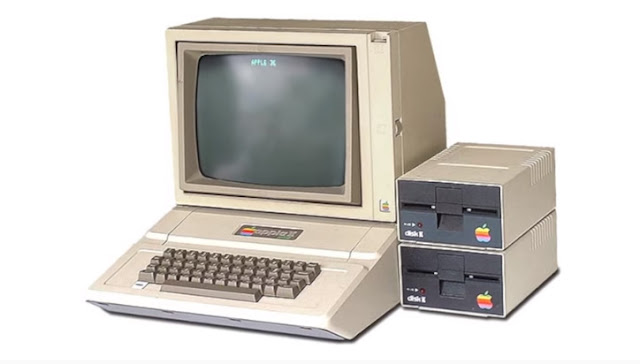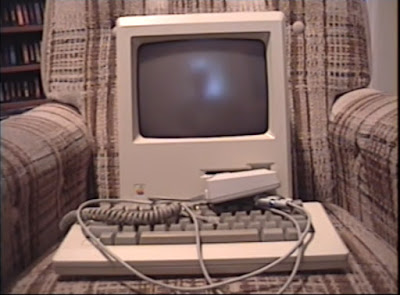It was suppose to revolutionize teaching, I think the Apple company was even involved, it got a ton of media attention, stories in the local paper, even made the nightly news. In the next two years, I only saw one teacher even turn the machine on and she just used it to play games while the class was taking a test or working on assignment. By my senior year, ever Mac was sitting on a shelf or filing cabinet gathering dust.
Hello, and welcome to another episode of The iBook Guy. I’m often criticized and called an Apple fan boy, told that I’m biased or not objective in regarding Apple products, and that’s just not true.
In fact, I’m often critical of Apple products, and including Steve Jobs as well, who I do respect but, he most certainly didn’t do everything right.
So, I thought I would create a little miniseries showing some of the things that I think Apple has done that are mistakes, and I’m going to start with a big one, all the way back in 1986, which is the Macintosh. Okay, so this is the Macintosh Plus.
Now, this is almost exactly like the original 1984 Macintosh, the only difference is just a slight memory upgrade. Now, this was Apples flagship product. This was the platform that was supposed to take their company into the future. Okay, now this is the Apple IIGS. This is essentially the upgrade from Apples aging Apple II line of products, which had been around since 1977. Alright, now get ready for me to blow your mind with a fascinating conspiracy theory. Both of these machines are on the market at the same time, in 1986. Let’s do a little comparison. First, let’s take a look at the raw hardware specifications.
Okay, so both machines had a 16-bit CPU. Now, the Macs CPU had almost three times the clock speed, though. Alright, now what might surprise you is that the Motorola chip used in the Mac was not as efficient per cycle as the WDC chip used in the Apple IIGS. But not only that, the Apple IIGS could actually run a lot faster, but Apple specifically limited in order to make sure it didn’t compete with the Macintosh.
How crazy is that? As for RAM, the Macintosh could support up to 4MB, whereas the IIGS could support up to 8MB, making the Apple IIGS the clear winner here.
Let’s look at the graphics. the Mac had a monochrome screen and let me be clear, it literally had only two colors; black or white. There were no shades of gray at all.
The Mac has a single 8-bit DAC for playing samples. Now, this was okay for putting little sounds into your programs. But synthesizing any sort of music required the CPU to do a lot of work. The IIGS on the other hand has a very advanced synthesizer chip, which can offload most of the work, so the CPU doesn’t have to do it; again, boosting the overall speed of the system, despite the slower clock speed. Again, the IIGS is clearly the winner. Okay, so what about expandability? Well, the Macintosh had essentially no internal expansion slots. It had the basic ports like serial, external drives, etc. But that was about it. The IIGS on the other hand had those same external ports, but also had eight internal card sockets that can be used for all sorts of things.
Once again, the IIGS is the clear winner in this category. Ok, so if the IIGS can do all of these things, surely it must be the most expensive product, right?
Well, you’d be wrong; the Mac sold for $2,599, whereas the IIGS sold for $999. Now you might say that comparison isn’t fair, because the Mac had a built-in monitor, whereas the IIGS customer would need to purchase that separately.
Okay, no problem. The monitor costs $499. So that’s more than a thousand dollars cheaper than the Mac. I’ll also point out that the IIGS was the first to introduce the ADB keyboard and mouse bus, where the Macintosh was still using a proprietary keyboard and mouse at this point in time.

Alright, so let’s bust two more misconceptions. Now, one thing one person might say is: well, what you were paying for with the Macintosh is the extravagant graphical operating system that was revolutionary and that the hardware in the Mac was specifically designed around this software, and what you’re going to see is that’s not entirely true.
But let me show you the IIGS running its own graphical operating system, known as GS OS. Not only does it look exactly like the Macs operating system, but it was also in full color, so I dare say it looked better, and provided a better overall experience to the user. It can also mount network shares from a Macintosh server, as well as read and write to Macintosh formatted floppy disks.
So somebody might say: well, the Apple IIGS is just a continuation of the Apple II line, and Apple really needed a fresh start with a new platform, in order to drop all of the, you know, the legacy stuff holding them back from advancing the platform a little more. Well, let me introduce you to this thing called the Mega-II chip. This chip is a complete Apple i.e. system integrated into a single chip.
This is the same chip that was used in the Apple I.e. card, that was later used to give the Macintosh LC backwards-compatibility with Apple II software. So, this same chip is essentially what gives the Apple IIGS backwards-compatibility with the Apple II, because otherwise, it is a completely new platform. Okay, so here’s what I’ve been building up to in this whole video. Why did Apple go ahead and dump and neglect this system, and discontinue it a few years later, and instead focus the entire company on advancing this product, when obviously, this product was overpriced and underpowered, compared to this one.

Now, the only conclusion I can come up with is Steve Jobs. Now, if you know the history of Apple, you know that he was essentially fired from the company, or at least kicked out of his job, and eventually they brought him back in and let him take over the Macintosh project. Now, the Macintosh was supposed to be a low-end consumer device.
It was actually kind of supposed to be a side project But he kind of took it over, beefed it up and essentially made it into Apples flagship product, probably in order to gain more control back in the company again. Now, by the time that the Mac Plus and the Apple IIGS were on the market, Steve Jobs has already gone again. However, I think what we’re seeing is, were still seeing the influence from when he was at the company.
So, I guess what I’m trying to say is I think the entire Macintosh line was a mistake from the very beginning. Apple should have been working on this product and advancing it. I think that during the 1990s, they would have been far more competitive than they were because they kind of got thrown back, lost a lot of their customer base, because of this product.
Now, I think today, if they were still in business, the products they would might be making today would probably be very similar to what they’re making now, and they would probably still be using Intel processors, and so on. They would have essentially came back to where they are now, but I think the company would have done better during the time that Apple almost went bankrupt, if they had followed the path of this machine instead of this one.
So that about wraps this up, so yeah. The first mistake I wanted to point out that Apple made was of course, building the Mac line. Now, I’ve got some other mistakes that I think they’ve made over the years.




Comments
Post a Comment